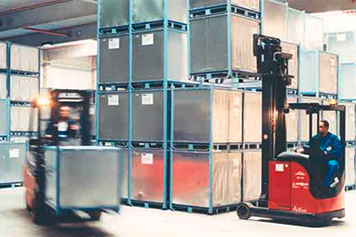Core processes
- Delivery transport
- Unloading
- Incoming goods
- Production warehouse
- Production
- Shipping warehouse
- Commissioning
- Shipping
- Loading
What does warehouse management stand for?

Warehouse management is understood to be both the accounting and physical management of warehouse stocks (and storage space stocks) as well as the control, organisation and monitoring of all warehouse processes. For every company that trades in goods, warehouse management is an important building block for a functioning supply chain. If, for example, warehouse capacities are not used efficiently or warehouse stocks are not reliably reported back, considerable additional costs can arise.
Functional areas
- Delivery of goods
- Unloading
- Incoming goods
- Internal warehouse processes
- Store /swap out/ restore
- Commissioning
- Shipping
- Loading
- Delivery
Which tasks does warehouse management entail?
The central tasks and functional areas of warehouse management are:
- Delivery of goods
- Unloading
- Incoming goods
- Internal warehouse processes (storage/removal/relocation)
- Commissioning
- Shipping
- Loading
- Delivery
This can also be simplified with the following questions:
1. Where from? i.e. where are the goods coming from? (e.g. supplier notification)
2. Where? i.e. where are storage spaces free? (e.g. for palettes or containers)
3. How? i.e. how are the items brought there (e.g. with forklift or conveyor system)
4. How much? i.e. how many items should be retrieved or removed.
5. Where to? i.e. where to should the goods be delivered (shipping address)
Furthermore, carrying out inventories is unavoidable in accounting terms. There are various processes for this.
Warehouse strategies
- FIFO
- LIFO
- First come, first served
What are warehouse strategies?
Warehouse strategies are policies according to which criteria goods should be stored or removed.
The most well-known strategies are FIFO (first in, first out) and LIFO (last in, first out).
Additionally, there is also "First come, first served".
Thus, when it comes to warehouse strategies, it's also about e.g. determining which goods should be removed first because they e.g. have an expiration date.
Short descriptions
- WMS
- SAP EWM
What is a WMS?
You may have heard this abbreviation used before in the context of warehouse management: a warehouse management system (WMS).
But what kind of systems are they and what are used for?
A warehouse management system (e.g. SAP EWM) is a piece of business commercial software that manages warehouse space numbers for companies as well as helping to handle warehouse movements in a flexible and automated fashion.
The WMS software (warehouse management systems) handles the complete control, monitoring and optimisation of challenging warehouse and distribution systems. That's why these systems are usually found in large warehouses and logistics centres.
The "classic" warehouse management functions such as storage / retrieval / relocation are very often complemented with extension modules such as e.g. commissioning control (e.g. Pick-by-Voice, Pick-by-Light, Pick-by-Motion) or material flow control (e.g. SAP MFS) or transport management systems (e.g. SAP TM).
Advantages of SAP
- ERP-Integration
- Existing transparency
- Process transparency
- Higher efficiency
What kinds of warehouse management systems are there?
In principle, a distinction is made between "self-sufficient" and "ERP-integrated" systems.
A self-sufficient warehouse management system (WMS) is a closed system. It can (if at all) only communicate with any other possible systems in company via complex technical interfaces.
Integrated warehouse management systems, on the other hand, are incorporated into an ERP system. All information from inventory management, production, order management, pricing, etc. is available in the overall ERP environment within a common system.
The advantages of SAP-integrated functions and business processes for warehouse management generate greater transparency of processes and inventories, precise planning of warehouse processes as well as efficient processes for distribution and storage - they form the heart of intra logistics.
With the help of an integrated solution, you can plan more flexibly and respond quickly to changing conditions. The seamless handling of incoming and outgoing goods processes allows you to integrate the process flows of the entire supply network. And with the comprehensive functions for warehouse management you're also best prepared for the challenges of complex warehouse environments.


![[Translate to English:] SAP Warehousing – Warehouse Management | IGZ](/fileadmin/user_upload/Warehousing/Lagerverwaltung/igz-sap-ewm-lagerverwaltung-header.jpg)